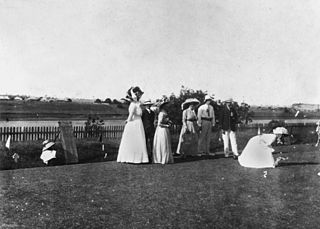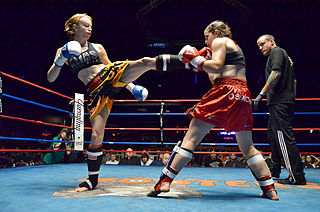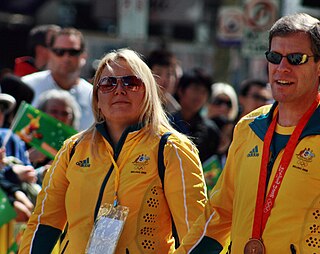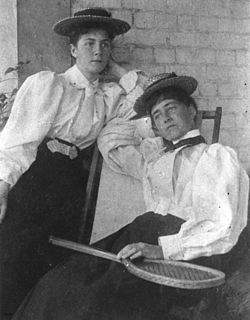 W
WWhile not being urged to avoid competition, women had few opportunities to compete in sport in Australia until the 1880s. After that date, new sporting facilities were being built around the country and many new sport clubs were created. Athletic events were being held in schools in Australia by the early part of the twentieth century. The Glennie School in Toowoomba was one school to host races for girls during their annual girls' sport day. During the 1920s, girls were able to run while wearing bloomers, instead of skirts. The first meeting for women's athletics took place in 1926 and was organised by the NSWAAA. The purpose of the meeting was to determine if it would be possible to send women to compete in the 1928 Summer Olympics based on merit. Only one female athlete was determined to be good enough to send. That was E.F. Robinson. The first women's national athletics body designed to govern the sport in Australia was founded in 1932 and was called the Australian Women's Amateur Athletic Union. It was designed to oversee state organisations in Victoria (1929), Queensland (1921), New South Wales (1932) and South Australia. (1932) The first Australian woman to travel overseas to compete was E.F. Robinson, who went to the 1928 Summer Olympics where she ran in the 100-metres. She came in third and was the only Australian female on the 1928 Australian Olympic team.
 W
WWomen's Australian rules football, also known simply as women's football or women's footy, is a form of Australian rules football played by women, generally with some modification to the laws of the game.
 W
WThe beginning of women's badminton in Australia dates back to the year 1900, when for the first time badminton was played in Australia.
 W
WThe first women's bowls match played in Australia took place in Stawell, Victoria in October 1881. The first women's only bowls club was not created for another seventeen years, when the Rainsford Bowls Club was created on 16 December 1898 at the home of J. Rainsford Needham, who lived in Glenferrie, Victoria. The first women's bowls association was created in September 1907. The association was called the Victorian Ladies' Bowling Association, and was created by six Melbourne, Victoria based clubs. It was the first women's bowling association created the world.
 W
W W
WWomen in Australia were participating in chess by the 1930s. Competitive tournaments were taking place on a state level by 1934.
 W
WCroquet has historically been a sport in Australia where men and women were able to compete on a level playing field.
 W
WWomen's cycling was controversial during the 1890s in Australia. The issue was discussed in several periodicals of the era including the Bulletin. There was a question of whether women should be allowed to ride bicycles in the first place, an issue settled in 1895 of yes. There was a question of the appropriate clothing to wear while riding a bicycle, if women should be allowed to compete in bicycle races, the most appropriate style of bicycle riding for women, if bicycle riding was good for a woman's health, and if the sport was appropriate for women to participate because of the possibility of making women more manly. Bicycle shops, such as Massey-Harris Bicycles of Brisbane, Rockhampton and Charters Towers, were catering to female customers by 1896. Malvern Star was also featuring female cyclists on the cover of their cycling catalogs during the same period. During the 1890s, cycling's popularity increased because it served several purposes, including transportation and recreation. It made parts of Australia more accessible to women than they had previously been.
 W
WDuring the 1900s in Australia, fencing became more socially acceptable for women to participate in and subsequently female participation rates rose in places like Queensland.
 W
WAustralia's fishing has been both an essential cultural pastime for women in pre-European Australia, and as a sport in recent times.
 W
W W
WWomen were involved with horse racing in Australia by the 1890s. Since then, they have owned horses, trained horses, gambled on horses and attended the races. Their participation in the sport was hampered because of a lack of facilities and participation rates were not as high as other sports.
 W
WWomen's kickboxing in Australia is not popular when compared to men's participation in the sport. Women have faced legal challenges in participating in New South Wales, which outlawed their participation in the ring. The sport has been embraced by Muslim women, who can be fully clothed while participating.
 W
WWhile not being urged to avoid competition, women had few opportunities to compete in sport in Australia until the 1880s. After that point, new sporting facilities were being built around the country and many new sport clubs were created. During the 1900s in Australia, lacrosse became more socially acceptable for women to participate in. Subsequently, female participation rates rose in places like Queensland.
 W
WNetball is the most popular women's team participation sport in Australia. In 1985, there were 347,000 players. In 1995, there were over 360,000 Australian netball players. Throughout most of Australia's netball history, the game has largely been a participation sport; it has not managed to become a large spectator sport. In 2005 and 2006, 56,100 Australians attended one to two netball matches. Of these, 41,600 were women. 46,200 attended three to five netball matches, with 34,400 of those spectators being women. 86,400 attended six or more netball matches, with 54,800 spectators being female. Overall, 188,800 people attended netball matches, with 130,800 being female. In 2005 and 2006, netball was the 10th most popular spectator sport for women with Australian rules football (1,011,300), horse racing (912,200), rugby league (542,600), motor sports (462,100), rugby union (232,400), football (212,200), harness racing (190,500), cricket (183,200) and tennis (163,500) all being more popular. The country set an attendance record for a netball match with a record crowd of 14,339 at the Australia–New Zealand Netball Test held at the Sydney Super Dome game in 2004.
 W
WMargaret Court was known by the British press as the 'Australian Amazon." She was one of the first Australian women to encourage women to integrate weightlifting into their training regime for other sports like tennis.
 W
WShooting was an important skill for women in the bush to possess. It was encouraged as part of self-reliance. Rifle shooting as a sport was being played in Queensland by 1914.
 W
W W
WThere are over eighty-nine roller derby leagues in Australia. in women's, men's, co-ed and junior categories.
 W
WIn 1940, a study of 314 women in New Zealand and Australia was done. Most of the women in the study were middle class, conservative, Protestant and white. The study found that 183 participated in sport. The nineteenth most popular sport that these women participated in was surfing, with 2 having played the sport. The sport was tied with cricket, mountaineering, and rowing.
 W
WWhile not being urged to avoid competition, women had few opportunities to compete in sport in Australia until the 1880s. After that date, new sporting facilities were being built around the country and many new sport clubs were created. One of the reason women were encouraged to play croquet, tennis and golf during the late 1800s was because it was seen as beneficial to their health. These sports were also seen as passive, non-aggressive and non-threatening to the period's concepts of masculinity and femininity.
 W
WVigoro is a team sport, played mainly by women in Australia, that originally combined elements of cricket and tennis, although in its current form it may be more similar to cricket and baseball.